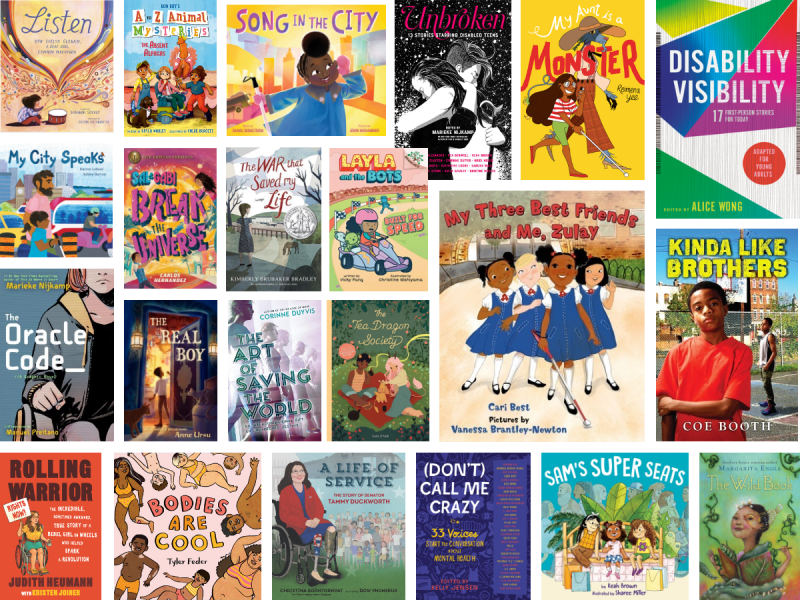Chapter book: Built For Speed by Vicky Fang
Middle grade: Kinda Like Brothers by Coe Booth, The Wild Book by Margarita Engle
Young adult: Unbroken: 13 Stories Starring Disabled Teens, edited by Marieke Nijkamp
Countering misinformation
Disability representation in kids’ literature can also educate readers about what living with a disability might look like or mean. These books help to counter misinformation, said Julia Torres, a librarian, educator and activist. Educators should steer away from “disability warrior” and “trauma warrior” tropes, said Perez. Although trauma might be part of someone’s experience with a disability, Torres said, “We can center a type of children’s literature where the disability is a part of a person’s lived experience and identity, just as a cultural or ethnic or linguistic identity is part of the human experience.”
Picture book: Sam’s Super Seats by Keah Brown and Sharee Miller
Chapter book: A-Z Animal Mystery by Kayla Whaley
Middle grade: Rolling Warrior: The Incredible, Sometimes Awkward, True Story Of A Rebel Girl On Wheels Who Helped Spark A Revolution by Judith Heumann with Kristen Joiner
Young adult: Disability Visibility: 17 First-Person Stories for Today, edited by Alice Wong
Disability representation in fantasy books
According to Perez, the fantasy genre is particularly lacking in disability representation. “People of all abilities can exist in any fantasy. We exist in real life. Why not in the fantasy world?” she asked. Duyvis pointed to her own novel, The Art of Saving the World, about a girl with an anxiety disorder who explores who she is through alternate universes, as an example of disability representation in fantasy. Another of Duyvis’ books, On the Edge of Gone is about an autistic girl who must prove herself worthy of securing a seat on the last generation ship to leave an apocalyptic earth. Just because the character is autistic “Does that make her any less worthy of survival?” Duyvis asked.
Middle grade: Sal and Gabi Break the Universe by Carlos Hernandez, My Aunt is a Monster by Reimena Yee, The Tea Dragon series by Kay O’Neill, The Real Boy By Anne Ursu
Young adult: The Oracle Code by Marieke Nijkamp
Appreciating different experiences
Disability representation in children’s literature is for everybody. “Whether you’re disabled or not, you can appreciate a book with a character who is or is not disabled,” said Duyvis. A reader who is disabled might read a book with disability representation and recognize themselves, while a non-disabled reader might recognize disability as “a little more normal,” she added.
Teachers can foster affirming and enriching conversations surrounding disability representation in children’s literature by asking: “What do you think of how other people in the book are reacting to the character?” If students are reading a book that includes an autistic character, the educator might ask them to think about what a singular character represents and explain that it “doesn’t necessarily mean that this is what any or all autistic people are actually like,” said Duyvis.
When students are encounter books that don’t represent disability in an inclusive or affirming way, Duyvis encouraged educators to promote critical thinking by having students ask themselves, “Can I necessarily trust what I read to be true?”
Torres recommended avoiding language like, “How did the person survive or thrive despite their disability?” Framing a disabled person’s existence “in spite” of their disability, can suggest that the person’s disability takes away from the value of their life. Torres said it might be helpful to ask these questions using affirming language instead:
- What did you learn about living with this particular disability?
- What are some misconceptions that you have unlearned?
- If you were to uplift things about the character what would those be?
When students have discussions about differences or disability representation in children’s literature, Perez likes to use the “mirrors and windows” approach. Students should see themselves, the mirror, but should also see others represented in what they read, the window. This can help to eliminate isolation.
Having these discussions in the classroom is not about garnering sympathy, said Torres. Rather, “it would feel beautiful not to have to explain.” Being open minded is the crux of disability inclusion and representation in kids’ literature. “Don’t limit an audience based on who the main character is,” said Duyvis.
Picture books: My City Speaks by Darren Lebeuf and Ashley Barron, A Life of Service: The Story of Senator Tammy Duckworth by Christina Soontornvat and Dow Phumiruk, Listen: How Evelyn Glennie, A Deaf Girl, Changed Percussion by Shannon Stocker
Middle grade: The War That Saved My Life by Kimberly Brubaker Bradley, El Deafo by Cece Bell
Young adult: (Don’t) Call Me Crazy: 33 Voices Start The Conversation About Mental Health, edited by Kelly Jensen


